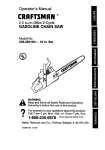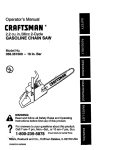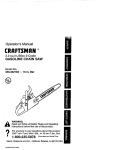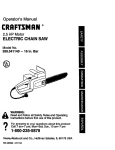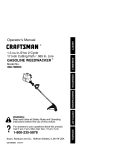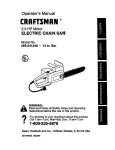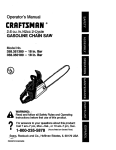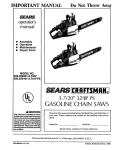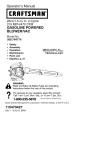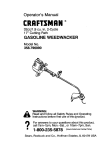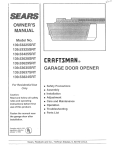Download Craftsman 358.351580 Operator`s manual
Transcript
Operator's Manual
CRRFTSHRN
2.4 cu. in./40cc 2-Cycle
_
GASOLINE CHAIN SAW
Model No.
358.351580 - 18 In. Bar
@
Read and follow
WARNING:; all Safety Rules and Operating
Instructions before first use of this product.
For answers
to your
questions
thispm,
product:
Call
7 am-7 pm,
Mon.--Sat.,
or about
10 am-7
Sun.
•
1-800-235-5878
(Hours listedare CentraITime)
Sea r_r_r__Roebuck
and Co., Hoffman Estates, IL 60179 USA
530087620
07/21/98
Warranty
Safety Rules
Assembly
Operation
-_
.... •_ Maintenance
Sewice and Adjustments
2
2
5
6
11
14
Storage
Trouble Shooting Chart
Repair Parts List
Spanish
Parts & Ordering
16
17
21
24
Back
FULL ONE YEAR WARRANTY ON CRAFTSMAN ® GAS
CHAIN SAW : i
For one year from _e date Ofpurchese, when this Craftsman Gas Chain Saw is
maintained, lubdcated and tuned-up accordingto the owner's manual, Sears will
repair,;:free_of
charge, any defect in material or workmanship.
This warranty dxcludes the bar, chain, spark plug and air filter,which are
expendable parts, and become wom during normal use.
If this Gas Chain Saw is used for commercial or rental purposes, this warranty
applies for 30 days from the date of purchase.
WARRANTY SERVICE iS AVAILABLE BY RETURNING THIS CHAIN SAW TO
THE NEAREST SEARS SERVICE CENTER IN THE UNITED STATES.
This warranty gives you specific legal rights, and you may also have other rights
which vary from state to state.
Sears, Roebuck and Co., D/817 WA, Hoffman Estat_s,;IL 60179
WARNING:
Always disconnect spark
plug wire when making repairs except
for carburetor adjustments. Because a
chain saw is a high-speed woodcutting
tool, careless or improper use of this
tool can cause serious injury.
PLAN AHEAD
• Restrict the use of your sew to adult
users who understand and can follow
the safety rules, precautions, and op" "_e_ating instructions found in this
manual.
Hearing
Protection_
Snug
Fitting _
Clothing
ShoesSafety
A.=_
___
i_r,_--
j
Safety Hat
Eye
Protection
Heavy Duty
Gloves
•
•
•
Safety Chaps
°
__ T_Jearprotective gear. Always use
steel-toed safety footwear with nonslip soles; snug-fitting clothing;heavy2
duty, non-slip gloves;eye protection
such as non-fogging,vented goggles
or face screen; an approved safety
hard hat; and sound barriers(ear
plugs or mufflers) to protect your
hearing. Regular users should have
hearing checked regularlyas chain
saw noise can damage hearing. Secure hair above shoulder length.
Keep all parts of your body away from
the chain when the engine is running.
Keep children, bystanders, and animals at least 30 feet (10 meters)
away from the work area when starting and usingthe saw.
Do not handle or operate a chain saw
when you are fatigued, ill, or upset, or
if you have taken alcohol, drugs, or
medication. You must be in good
physicalconditionand mentally aiert.
If you have any conditionthat might
be aggravated by strenuouswork,
check with doctor before operating.
Do not start cuttinguntilyou have a
clear work area, secure footing, and
especially if you are felling a tree, a
retreat path.
OPERATE YOUR SAW SAFELY
• Do not operatewithonehand.Sedousinjuryto the operator,helpers,or
bystandersmayresult from one•
•
•
•
•
•
handed operation. A chain saw is intended for two-handed use.
Operate the chain sa3vonly in.a wailventilated outdoor area.
Do not operate saw from a ladder or
in a tree, unless you are specifically
trained to do so.
Make sure the chain will not make
contact with any object while starting
the engine. Never try to start the saw
when the guide bar is in a cut.
Do not put pressure on the saw, especially at the and of the cut. Doing
so san cause you to lose control
when the cut is completed.
Stop engine before setting sew down.
Hand carry saw only when engine is
stopped. Carry with muffler away from
body; guide bar & chain projecting behind you; guide bar preferably covered with a scabbard.
MAINTAIN
YOUR
SAW IN GOOD
WORKING
ORDER
• Have all chain saw service performed
by a qualified service dealer except
the items listed in the maintenance
section of this manual.
• Make certain the saw chain stops
moving when the throttle tdgger is released. For correction, refer to =Carburetor Adjustments."
• Keep the handles dry, clean, and free
from oil or fuel mixture.
• Keep caps and fasteners securely
tightened.
• Use only Craftsman accessodes and
replacement parts as recommended.
Nev_e_r_modifyyour saw.
• Store the unit and fuel in a cool, dry
well ventilated space where fuel vapors cannot reach sparks or open
flames from water heaters, electric
motors or switches, furnaces, etc.
GUARD
AGAINST
KICKBACK
Follow.all safety rules to help avoid
Idcld0ack and other forces which can
result in sedous injury.
_
_
KickbackPath
Avoid Obstructions
Clear The Worldng Area
WARNING: Rotational Kickback can
occur when the moving chain contacts
an object at the upper portion of the tip
of the guide bar. Contact at the upper
portion of the tiP of the guide bar can
cause the chain to dig into the object,
which stops the chain for an instant.The
resultis a lightningfast, reverse reaction
which kicksthe guide bar up and back
toward the operator.
Pinch-Kickbeckand Pull-In occur when
the chain is suddenly stopped by being
pinched, caught, or by contacting a foreign object in the wood. This sudden
stopping of the chain results in a reversal of the chain force used to cut wood
and causes the saw to move in the opposite direction of the chain rotation.
Pinch-Kickbackdrives the saw straight
back toward the operator. Pull-In pulls
the saw away from the operator.
REDUCE THE CHANCE OF
KICKBACK
HANDLE
FUEL WIT.[-I CAUTION
• Do not smoke while handling fuel or
while operating the saw.
• Eliminme_I sourcasofspsrksor tiame • Recognize that kJdd:_ck can happen.
With a basis understanding of k_k,
in areas where fuel is mixed or poured.
you can reduce the element of surprise
• Mix and pour fuel in an outdoor area
which contributes to accidents.
and use an approved, marked container for all fuel purposes. Wipe up
any
object
at the
tip ofchain
the guide
bar.
Never
let the
moving
contact
all fuel spills before starting saw.
Keep working area free from obstruc• Move at least 10 feet (3 meters) from
tions such as other trees, branches,
fueling site before starting.
rocks, fences, stumps, etc. Eliminate
• Turn the engine off and let sew cool in
or avoid any obstruction that your saw
a non-combustible area, not on dry
chain could hit while cutting.
"le,a_e_, straw, paper, etc. Slowly re• Keep saw chain sharp and propedy
tensioned. A loose or dull chain can
move fuel cap and refuel unit.
3
increase the chance of kickback. Follow manufacturer's chain sharpening
and maintenance instructions. Check
tension at regular intervals, but never
with engine running. Make sure bar
clamp nuts are escurely tightened.
• Be(] n and continue cuffing at lull
sp_ed. If the chalh is movin_ at a
slower speed, there is greater chance
of kickback occurring.
• Use extreme caution when reentering
a cut.
Do not attempt cuts startLngwith the
i tip.of the bar._lunge cuts).
Watch for sh=ftinglogs or other forces
that could close a cut and pinch or fall
into chain.
• Use the specified Reduced-Kickback
Guide Bar and Low-Kickback Chain.
Avoid Pinch-Kickback:
• Be extremely aware of situations or
obstructionsthat can cause matenau
to pinch the top of or otherwise stop
the chain.
• Do not cut more than one log at a
time.
• Do not twist saw as bar is withdrawn
from an undercut when bucking.
Avoid Pull-In:
• Always begin cutting with the engine
at fullspeed and the saw housing
against wood.
• Use wedges made of plastic or wood.
Never use metal to hold the cut open.
MAINTAIN CONTROL
Stand to the left of the saw
keep y.our body from being in a direct
line with-the cutting chain.
• Stand with your weight evenly balanced on both feet.
• Do not overreach. You could be drawn
or thrown off balance and lose control.
• Do not cut above.shoulder height, it is
difficultto maintain control of saw
above shoulder height.
KICKBACK SAFETY FEATURES
WARNING: The followingfeatures are
included on your saw to help reduce
hazard of kickback;however, such features will not totally eliminate this danger. Do not rely only on safety devices.
• Handguard: designed to reduce the
chance of your left hand contacting
the chain ifyour hand slips off the
front handlebar.
• Position of front and rear handlebars:
designed with distance between handles and "in-line"with each other. The
spread and "in-line" position of the
hands provided by this design work
together to give balance and resistance in controllingthe pivot of the
saw back toward the operator if kickback occurs.
• Reduced-Kickback Guide Bar: designed with a _;mall radius tip which
reduces the size of the kickback danger zone. This type bar has been
demonstrated to significantlyreduce
the number and seriousness of kickbacks when tested in accordance with
ANSI B175.1.
Smell Radius
Tip Guide Bar
Thumb on
_
\_
Elbow
• Low-KickbackChain: has met kickback
performance.mq..uirarnants
when tested
on a representativesample of chain
Never reverse hand _)osit]or)s
saws below 3.8 cubic inch
• A good, firm grip on the saw with both
displacementspecifiedin ANSI B175.1.
locked
hands will he|p you maintain control.
Don t let go. Grip the rear handle with
your dght hand whether you are dght
or left handed. Wrap the fingers of
your left hand over and around the
front handlebar, and your left thumb
under the front handlebar. Keep your
left arm straight with the elbow locked.
• Position your left hand on the front
Low-Kickback Chain
Contoured Depth Gauge
Deflects Kickback
_._....
ForceAndAllows
WoodTo
Elon_tsd Gradually
Guard Unk
RideIntoCutter
SAFETY NOTICE: Exposure to
vibrations through prolonged use of
,
handlebar so it is in a straight line with gasoline powered hand tools could .
• _--yeur dght hand on the rear handle
when making bucking cuts. Stand
cause blood vessel or nerve oamagelm
the fingers, hands, and joints of peop e
slightly to the left side of the saw to
4
prone to circulation disorders or
abnormal swelling. Prolonged usa in
cold weather has been linked to blood
vessel damage in otherwise healthy
people• if symptoms occur such as
numbness, pain, loss of strength,
change in skin color or _exturs, orJoss
of feeling in the fingers, hands, or joints,
discontinue the use of this tool and
seek medical attention. An
anti-vibration system does not
guarantee the avoidance of these
problems. Users who operate power
tools on a continual and regular basis
must closely monitor their physical
condition and the condition of this tool•
CHAIN BRAKE If this saw is to be used
for commercial logging, you must order
and install a chain brake to comply with
Federal OSHA Regulations for Commercial Logging• Contact your Sears
Service Center or call 1-800-235-5878.
SPARK ARRESTOR:
Your saw is
equipped with a temperature
limiting
CARTON
CONTENTS
Check carton contents against the following list.
Model: 358.351580
•
•
•
•
muffler and spark arresting screen
which meets the requirements of
Califomia Codes 4442 and 4443. All
U•S. forest land and the states of
Califomia, Idaho, Maine, Minnesota,
New Jersey, Oregon, and Washington
require bY law that many intemal
combustionengines be equipped with a
spark arrestor screen. If you operate a
chain saw in a state or locale where
such regulationsexist, you are legally
responsiblefor maintainingthe
operating conditionof these parts.
Failure to do so is a violationof the law.
Refer to Customer Responsibilities
chart in the MAINTENANCEsection.
STANDARDS: This chain saw is listed
by UnderwritersLaborstodes, Inc. in
accordance with American National
Standards for Gasolins-Powersd Chain
Saws Safety Requirements (ANSI
B175.1-1991).
Chain Saw (fully assembled)
Chain adjustment tool
2-cycle engine oil
Examine parts for damage. Do not
use damaged parts.
• If you need assistance or find that
parts are missing or damaged, please
call 1-800-235-5878.
NOTE: It is normal to hear the fuel filter
rattle Jn an empty fuel tank.
Your unit has been factory tested and
the carburetor precisely adjusted. As a
result you may smell gasoline or find a
drop of oil/fuel residue on the muffler
when you unpack the unit.
ASSEMBLY
Your saw is fully assembled, and no
assembly is necessary.
5
KNOW YOUR SAW
READ THIS OPERATOR'S MANUAL AND SAFETY RULES BEFORE OPERATING YOUR CHAIN SAW. Compare the illustrationswith your unitto familiarize
yourself with the 10eationof the various controlsand adjustments. Save this
manual for future reference.
....
;_zM__tler_""'_
_
__B_I
er
/Starter//
Bar Oil Fill Cap
Housing
Fuel Mix Fill Cap
Cylinder Cover
Fast Idle
Rsar
Handle
Throffie
Trigger
Adjusting
Screw
Chain
Direction
of Travel
Choke
_
Bar Clamp Nuts Guide Bar
Knob Bar Clamp Chain
Catcher
THROTTLE LOCKOUT
The throttle lockout must be pressed
before you can squeeze the throttle trigge_. This feature prevents you from accidentally squeezing the trigger.
CHOKE/FAST
IDLE LI_VER
The choke and fast idle speed are set
by pulling the choke lever out fully for
cold or for refueled starting. The choke
provides additional fuel when starting a
cold engine.
CHAIN TENSION
It is normalfor a new chain to stretch
duringfirst 30 minutes of operation. You
should check your chain tension frequently.See Chain Tension under the
Service and Adjustmentssection.
6
BEFORE STARTING ENGINE
WARNING: Be sureto readthe fuel
handlinginformationinthe safetyrules
sectionof this manualbeforeyoubegin.
If youdo not understandthe fuel handlinginformationdo notattempttofuel
yourunit.Seekhelpfr0_ someone that
does understand the informationor call
the customer assistance help line at
1-800-235-5878.
GUIDE BAR AND CHAIN OIL
The chain oiler provides continuous lubrication to the chain and guide bar. Be
sure to fill the bar oil tank when you fill
the fuel tank (Capacity = 6.8 ft. oz.)
For maximum guide bar and chain life,
we recommend you use Craftsman
chain saw bar oil. If Craftsman bar oil is
not available, you may use a good
grade SAE 30 oil until you are able to
obtain Craftsman brand. The oil output
is automatically metered during operation. Your saw will use approximately
one tank of bar oil for every tank of fuel
mix. Always fill the bar oil tank when
you fill the fuel tank.
FUELING ENGINE
This engine is certified to operate on
unleaded gasoline. Before operation,
gasoline must be mixed with a good
quality 2-cycle air-cooled engine oil. We
recommend Craftsman brand oil. Mix
gasoline and oil at a ratio of 40:1 (A
40:1 ratio is obtained by mixing 3.2
ounces of oil with 1 gallon of unleaded
gasoline). DO NOT USE automotive oil
or boat oil. These oils will cause engine
damage. When mixing fuel follow the
instructions printed on the container.
Once oil is added to the gasoline,
shake container momentarily to assure
that_LIl_ fuel is thoroughly mixed.
Always read and follow the safety rules
relating to fuel before fue.ling your unit.
IMPORTANT
Experience indicates that alcohol
blended fuels (called gasohol or using
ethanol or methanol) can attract moisture which leads to separation and
formation of acids during storage. Acidic gas can damage the fuel system of
an engine while in storage.
To avoid engine problems, the fuel system should be emptied before storage
for _)._lays or longer. Drain the gas
tank, start the engine and let it run until
the fuel lines and carburetor are empty.
Use fresh fuel next season. See STORAGE instructions for additional information.
Never use engine or carburetor cleaner
products in the fuel tank or permanent
damage may occur.
See the STORAGE section for additional
information..
STOPPING
YOUR ENGINE
• Move On/Stop switch to the STOP
position.
• If engine does not stop, pull choke
knob out fully.
STARTING
YOUR ENGINE
COLD ENGINE OR WARM ENGINE
AFTER RUNNING OUT OF FUEL
• Fuel engine following instructions under FUELING ENGINE.
• Fill bar oil tank with bar oil. Your saw
will use approximately one tank of bar
oil for each tank of fuel mix.
• Move On/Stop switch to ON position.
• Pull choke knob out fully.
° Prime engine by slowly pressing primer bulb six times.
ON/STOP
Switch
Primer Bulb
• Set saw on the ground. Grip front
handle with your left hand and place
rightfoot through rear handle.
Choke knob
NOTE: When pulling the starter rope,
do not use the full extent of the rope.
Do not let starter rope snap back.
Hold handle. Let rope rewind slowly.
• Sharply pull starter rope handle 5
times with your right hand. The engine may sound as if it is trying to
start before the 5th pull; if so, proceed
to the next step.
7
• Fullypush-inchokeleverandcontinnot successful, repeat untilengine
ueto pull starterropehandleuntilen- starts.
ginestarts.
Starting could require many pullsde• Then, squeeze and release the
throttle trigger to retum engine to idle
speed.
• To stop engine, move _Q+_Stop switch
to the STOP position.
Starter Rope Handle
r
Righi_:FootThrough Rear Handle
STARTING A WARM ENGINE
DO NOT use the choke to start a warm
engine or flooding and hard starting
mayoccur,
• Move On/Stop switch to ON.
• Slowly press primer bulb 6 times.
• Set the chain saw on the ground. Grip
the front handle with your left hand
and place your right foot through the
opening in the rear handle.
• Pull choke lever out fully, then push it
in fully to set engine in fast idle positon.
• Sharply pull starter rope handle with
your right hand until the engine starts,
but no more than 5 times.
• Then, squeeze and release the
throttle triggsr to retum engine to idle
speed.
• To stop engine, move On/Stop switch
to the STOP position.
'I_I=FICULT
STARTING
OR
STARTING
A FLOODED
ENGINE
The engine may be flooded if it has not
started after 10 pulls. Flooded engines
can be cleared of excess fuel with the
following procedure:
• Pull choke lever out fully, then push it
in fully to set engine in fast idle positon.
• Verify that the On/Stop switch is in the
ON position.
• With saw on ground, grip front handle
with left hand and place right foot
__through rear handle.
• Grip starter rope handle and pull rope
firmly and quickly to start engine. If
pending on how badly unit is flooded. If
engine stillfails to start, refer to TROUBLESHOOTING chart or call
1-800-235-5878.
OPERATING TIPS
• Check chain tension before first use
and after 1 minute of operation. See
Chain Tension in the Maintenance
section.
• Cut wood only. Do not cut metal, plastics, masonry, non-wood building materials, etc.
• Stop the saw if the chain strikes a foreign object. Inspectthe saw and repair parts as necessary.
• Keep the chain out of dirt and sand.
Even a small amount of dirtwill quickly dull a chain and increase the possibilityof kickback.
• Practice cutting a few small logs using
the following steps. This will help you
get the =feel" of using your saw before
you begin a major sawing operation.
• Squeeze the throttletrigger and allow the engine to reach full speed
before cutting.
• Begin cuttingwith the saw frame
against the log.
• Keep the engine at full speed the
entire time you are cutting.
• Allow the chain to cut for you. Exert
only lightdownward pressure.
• Release the throttle trigger as soon
as the cut is completed, allowingthe
engine to idle. Ifyou run the saw at
full throttle without a cuttingload,
unnecessary wear can occur.
• To avoid losingcontrol when cut is
complete, do not put pressure on
saw at end of cut.
• Stop the engine before setting the
saw down.
TREE
FELLING
TECHNIQUES
WARNING:
Check for broken or dead
branches which can fall while cutting
causing serious injury. Do not cut near
buildings or electrical wires if you do not
know the direction of tree fall, nor cut at
night since you will not be able to see
well, nor during bad weather such as
rain, snow, or strong winds, etc.
Carefully plan your sawing operation in
advance. Clear the work area. You
need a clear area all around the tree so
you can have secure footing. Study the
8
naturalconditionsthatcan causethe
This hinge will help prevent the tree
from falling in the wrong direction.
tree to fall in a particular direction, such
conditions include:
• The wind direction and speed.
• The lean of the tree. The lean of a
tree might not be apparent due to uneven or sloping terraiB. Use a plumb
or level to determine the direction of
tree lean.
• Weight and branches on one side.
• Surrounding trees and obstacles.
Rrst cut
Notch,_
Look for decay and rot. If the trunk is
rotted, it can snap and fall toward the
operator.
Make sure there is enough room for the
tree to fall. Maintain a distance of 2-1/2
tree lengths from the nearest person or
other objects. Engine noise can drown
out a warning call.
Remove dirt, stones, loose bark, nails,
staples, and wire from the tree where
cuts are to be made.
Plan a clear retreat path
....
(
]--,,,=-_-
Direction of Fall
FELLING LARGE TREES
(6 inches in diameter or larger)
The notch method is used to fell large
trees. A notchis cut on the side of the
tree in the desired directionof fall. After
a felling cut is made on the opposite
side of tree, the tree should fall in the
direction of the notch.
NOTE: If the tree has large buttress
roots,_move
them before making the
notch.
NOTCH CUT AND FELt.ING TREE
• Make notch cut by cutting the top of
the notch first. Cut through 1/3 of the
diameter of the tree. Next complete
the notch by cutting the bottom. See
illustration. Once the notch is cut remove the wedge of wood from the
tree.
• After removing the wood, make the
felling cut on the opposite side of the
notch. This is done by making a cut
abouttwo inches higher than the canter..e._the notch. This will leave
enough uncut wood between the felling cut and the notch to form a hinge.
|
_'.':
Rnal cut here
r
Hinge holds tree on stump and helps
controlfell
Opening
of telling
Closingof
notch
NOTE: Before felling cut is complete,
use wedges to open the cut when
necessary to control the direction of fall.
To avoid kickback and chain damage,
use wood or'plastic wedges, but never
steel or iron wedges.
• Be alert of signs that the tree is ready
to fall: cracking sounds, widening of
the felling cut, or movement in the upper branches.
• As tree starts to fall, stop sew, put it
down, and get away quickly on your
planned retreat path.
• Be extremely cautious with partially
fallen trees that may be poody supported. When a tree doesn't fall completely, set the saw aside and pull
down the tree with a cable winch,
block and tackle, or tractor. Do not
use your saw to cut down a partially
fallen tree.
CUTTING A FALLEN TREE
(BUCKING)
Bucking is the term used for cutting a
fallen tree to the desired log size.
WARNING:
Do not stand on the log
being cut. Any portion can roll causing
loss of footing and control. Do not stand
downhill of the log being cut.
IMPORTANT POINTS
• Cut only one log at a time.
• CUt shattered wood very carefully;
sharp pieces of wood could be flung
toward operator.
9
• Use a sawhorse to cut small logs.
Never allow another person to hold
the log while cutting and never hold
the log with your leg or foot.
• Do not cut in an area where logs,
limbs, and roots are tangled. Drag the
logs into a clear _,rea before cutting
them.
BUCKING TECHNIQUES
WARNING: If saw becomes pinched
or hung in a log, don't try to force it out.
You can losecontrol of the saw resulting in injury and/or damage to the saw.
Stop the saw, ddve a wedge of plastic
or wood into the cut untilthe saw can
be removed easily. Restart the saw and
carefully reenter the cut. Do not use a
metal wedge. Do not attempt to restart
your saw when it is pinched or hung in
a log.
Rrst cut on pressure side of log
BUCKING WITHOUT A SUPPORT
• Ovemut through 1/3 of the diameter of
the log.
• Roll the log over and finish with a second overcut.
• Watch for logswith a pressure side.
See illustrationabove for cuttinglogs
with a pressure side.
Using s log
for support
Use a wedge to remove pinchedsaw
_.
Turn saw OFF and
A_.'_
use a plastic or wooden
Overcutting
Undercutting
Undercutting involves cutting on the
underside of the log with top of saw
. a_galnstthe log. When undemutting use
light upward pressure. Hold saw firmly
and maintain control. "l:'hesaw will tend
to push back toward you:
2
Cut,_k
--
1st cut
st Cut
to force cut open.
Overcutting begins on the top side of
the log with the bottom of the saw
against the log. When overcutting use
light downward pressure.
nd
2 ndCut
BUCKING USING A LOG OR
SUPPORT STAND
• Remember your first cut is always on
the pressure side of the log.
(Refer to the illustration below for your
first and second cut)
• Your first cut should extend 1/3 of the
diameter of the log.
• Finish with your second cut.
Using s su_
Cut
WARNING:
Never tum saw upside
down to undercuL The saw cannot be
controlled in this position.
Always make your first cut on the pressure side of the log.
1stCut
/
Rrst cut on pressure side of log
10
LIMBING AND PRUNING
with the 1/3,2/3 cuttingtechniques descdbed in the bucking section.
WARNING: Neverclimbintoa treeto
•
limbor prune.Donot standon ladders, Always usa an overcut to cut small
and freely hanging limbs. Undercutplatforms,a log,or in anyposition
ting
could cause limbsto fall and
whichcancauseyouto loseyour balpinch the saw.
anceor controlofthe saw.
IMPORTANTPOINTS_
.....
PRUNING
• Watch out for springpoles.
Springpoles are small size limbs
which can whip toward you, or pull
WARNING: Limit pruningto limbs
shoulder height or below. Do not cut if
branches are higher than your shoul-
you off balance. Use extreme caution
when cutting small size limbs.
• Be alert for springback. Watch out for
branches that are bent or under pressure. Avoid being struck by the
branch or the saw when the tension in
the wood fibers is released.
• Frequently clear branches out of the
way to avoid tdpping on them.
LIMBING
• Limb a tree only after it is cut down.
• Leave the larger limbs underneath the
felled tree to support the tree as you
work.
• Start at the base of the felled tree and
work toward the top, cutting branches'
and limbs. Remove small limbs with
one cut.
• Keep the tree between you and the
chain.
• Remove larger, supporting branches
der. Get a professional to do the job.
• Make your first cut 1/3 of the way
through the bottom of the limb.
• Next make a second cut all the way
through the limb.
• Finish the pruning operation by using
an overcut so that the stump of the
limb protrudes 1 to 2 inches from the
trunk of the tree.
CUSTOMER
Second cut
First cut
1/3 of way
3rd cut 1 to 2 in.
RESPONSIBILITIES
Fill in dates as you complete
regular service
Check for damaged/worn
Service
Dates
Every
25 hrs
parts
Check for loose fasteners/parts
Chi_l_ chain tension
Check chain sharpness
:
Check guide bar
Clean unit & labels
Clean air filter
Clean/inspect spark arrestor
screen & inspect muffler
y-
Replace spark plug
11
GENERAL RECOMMENDATIONS
The warranty on this unit does not cover items that have been subjected to
operator abuse or negligence. To receive fullvalue from the warranty, the
operator must maintain unit as instructed in this manual. _arious adjustments
will need to be made periodically to
properlymaintain your unit.
• Once a year, replace the spark plug,
air filter element, and check guide bar
and chain for wear. A new spark plug
and air filter element assures proper
air-fuel mixture and helps your engine
run better and last longer.
WARNING: Disconnect the spark plug
before performing maintenance except
for carburetor adjustments.
• Handle Screws
• VibrationMounts
• Starter Housing
• Handguard
CHECK CHAIN TENSION
• Use the screwdriver end of the bar
tool to move chain around guide bar
to ensure kinks do not exist. The
chain should rotate freely.
LUBRICATION
• Loosen bar clamp nuts untilthey are
finger tight againstthe bar clamp.
• Turn adjustingscrew untilchain barely touchesthe bottom of guide bar.
II
1 Bar
2 Bar Oil
Sprocket
Fill Cap
Lube
.
_
_
1 Sprocket lube
2 Craftsman chain saw bar oil
_
BarClampNuts
f
_
_'_r_n_
• Using bar tool,rollchainaround guide
CHECK FOR DAMAGED OR
bar to ensure all linksare in bar groove.
WORN PARTS
• Lift up tip of guide bar to check for
Replacement of damaged/wom parts
sag. Release tip of guide bar, then
should be referred to your Sears Serrum adjustingscrew untilsag does
vice Center.
not exist.
NOTE: It is normal for a small amount
• While liftingtip of guide bar, tighten
of oil to appear under the saw after enbar clamp nuts with the bar tool.
gine stops. Do not confuse this with a
Torque to 10-15 ft-lbs.
leaking oil tank.
• On/Stop Switch - Ensure On/Stop
switchfunctions properly by moving
. the switch to the "Stop" position.
" "Make sure engine stops;then restart
engine and continue.
• Fuel Tank - Discontidue use of chain
saw if fuel tank shows signs of dam• Use the screwdriver end of the bar
age or leaks.
tool to move chain around guide bar.
• Oil Tank - Discontinue use of chain
• If chain does not rotate, it is too tight.
saw if oil tank shows signs of damage
Slightly loosen bar clamp nuts and
or leaks.
loosen chain by turning the adjusting
CHECK FOR LOOSE
FASTENERS AND PARTS
• Bar Clamp Nuts
• Chain
• Muffler
-, .._Cylinder Shield
• Air Filter
• Clutch Drum/Sprocket
screw. Retightan bar clamp nuts.
• If chain is too loose, it will sag below
the guide bar. DO NOT operate the
saw if the chain is loose.
CHECK CHAIN SHARPNESS
A sharp chain makes wood chips. A
dull chain makes a sawdust powder
and cuts slowly.
12
CHAINSHARPENING
Chainsharpeningrequiresspecial
tools.Youcan purchasesharpening
toolsat Searsor goto a professional
chainsharpener.
CHECK GUIDE BAR_
.......
Conditions which require guide bar
maintenance:
• Saw cuts to one side or at an angle.
• Saw has to be forced through the cut.
• Inadequate supply of oil to the bar
and chain.
Check the condition of the guide bar
each time the chain is sharpened. A
wom guide bar will damage the chain
and make cuffing difficult. To maintain
guide bar:.
• Move On/Stop switch to =Stop."
• Remove bar and chain from saw.
• Clean all sawdust and any other
debris from the guide bar groove and
sprocket hole after each use.
Remove Sawdust From Guide
Bar Groov_
• Add lubricant to sprocket hole after
each use.
• Burring of guide bar rails is a normal
process of rail wear. Remove these
burrs with a fiat file.
• When rail top is uneven, use a fiat file
to restore square edges and sides.
ment is necessary, use only the guide
bar specif'md for your saw in the repair
pads list, also specified on the replacement bar and chain decal located on
the chain saw.
CLEAN UNIT & LABELS
• Clean'the unit using a damp cloth with
a mild detergent.
• Wipe off the unit with a clean dry
cloth.
CLEAN AIR FILTER
A dirty air filter decreases the life and
performance of the engine and increases fuel consumption and harmful
emissions. Always clean your air filter
after 15 tanks of fuel or 5 hours of operation, whichever comes first. Clean
more frequently in dusty conditions. It is
advisable to replace your air filter with a
new one after every 50 hours of operation, or annually, whichever comes firsL
To clean filter:.
• Loosen 3 screws on cylinder cover.
• Remove cylinder cover.
• Remove air filter.
• Clean the air filter using hot soapy
water. Rinse with clean cool water.
Air dry completely before remstalhng.
• Lightly oil air filter before installing.
Use 2-cycle engine oil or motor oil
(SAE 30). Squeeze excess oil from
filter."
the air filter.
• Reinstall air filter•
• Reinstall cylinder cover and 3 screws
(15-20 in-lbs.).
Air Filter
File Edges and
sides Square
Worn G-roove
Correct Groove
Replace the guide bar w_hen.the groove
is wom, the guide bar is berit or
cracked, or when excess- heating or
burring of the rails occurs• If replace-
13
Cover
Screws
INSPECT MUFFLER AND SPARK • Replaceany broken or cracked mufARRESTOR SCREEN
As the unit is used, carbon deposits
build up on the muffler and spark
arrestor screen, and must be removed
to avoid creating a fire hazard or affecting engine performance. ....
Replace the spark arrestor screen if
breaks occur.
Muffler Diffuser
fler parts.
• Reinstall diffuser and spark arrestor
screen assembly with holes facing up
and towards muffler cover.
• Reinstall muffler cover and 2 screws
(-/-8 ft-lbs.).
REPLACE SPARK PLUG
The spark plug should be replaced
each year to ensure the engine starts
easier and runs better. Ignitiontiming is
fixed and nonadjustable.
Muffler • Loosen the 3 screws on the cylinder
cover.
Cover
Screws • Remove the cylinder cover.
• Pull off the spark plug boot.
• Remove spark plugfrom cylinder and
discard.
•
Replace with Champion CJ7Y spark
Body
Muffler
Cover
plug and tighten with a 3/4 inch socket
wrench (10-12 ft-lbs). Spark plug gap
should be .025 in.
CLEANING THE SPARK
ARRESTOR SCREEN
• Reinstall the spark plug boot.
• Reinstall the cylindercover and 3
Cleaning is required evew 25 hours of
screws (15-20 in-lbs).
operation or annually, whichever comes
first.
• Loosen and remove the 2 muffler cov- Screws
er screws.
Cylinder
• Remove the muffler cover (cover
snaps off muffler body).
Plug
• Remove muffler diffuser and spark
Boot
arrestor screen assembly. Notice the
orientationof these pads for reassembling.
• Clean the spark arrestor screen with a
Spark
wire brush. Replace screen if breaks
Plug
are found.
and chain is also specified on a decal
.CH_AIN REPLACEMENT
CAUTION: Wear protective gloves
when handling chain. "l_hechain is
sharp and can cut you even when it is
not moving.
•
•
located on the chain saw.
See your Sears Service Center to replace and sharpen individualcutters
on your chain.
Remove bar clamp nuts.
Remove bar clamp.
Remove the old chain.
It is normal for a new chain to stretch dur- •
ing the first 15 minutes of oparation. You
•
should recheck your chain tension frequenify and adjust the chain tension as
required. See Chain Tension section.
Bar
• Move On/Stop switch to the Stop
Clamp
position.
• Replace the old chain when it becomes worn or damaged.
" --_U_e only the Low-Kickback replacement chain specified in the repair
parts list. The correct replacement bar
14
Bar
Clamp Nuts
your protsctive equipment and observe
all safety precautions.Dudng the low
speed mixtureadjustment recheck idle
speed after each turn of the screw. The
chain must not move at idle speed.
(_'-0
_
.Carburetor adjustment is cdtical and if
done impropedycan permanently damage the engine as well as the carburetor. If you require furtherassistance or
are unsure about performing this proceTensioning Rack
/
dure, call our customer assistance help
• Slide the guide bar rearward until it
line at 1-800-235-5878.
stops against the sprocket.
Old fuel, a dirtyair filter,dirty fuel filter,
• Carefully remove new chain from
or flooding may give the impression of
package. Hold chain with the drive
an improperlyadjusted carburetor.
links as shown.
Check these conditionsbefore adjustCutters
Dep_ Gauge
Ing the carburetor.
The carburetorhas been carefully set at
the factory. Adjustments may be necessary if you notice any of the following
conditions:
• Chain moves at idle. See =IdleSpeed"
Drive Links
under adjustingprocedure.
• Place chain over and behind clutch.
• Saw will not idle. See =Idle Speed"
• Fit the bottom of the drive links beand "Low Speed Mixture'under adtween the teeth in the sprocket nose.
justing procedure.
• Fit chain drive links into bar groove.
• Engine die._or hesitates when it
• Pull guide bar forward until the chain
should accelerate. See =Acceleration
is snug in the guide bar groove.
ChecW'under adjustingprocedure.
• Install the bar clamp.
• Lose of cutting power. See =High
• Install bar clamp nuts; finger tighten
Speed Mixture H" under adjusting
only. Do not tighten any further at this
procedure.
point.
There are three adjustment screws on
the carburetor.They are labeled H, L,
and T. They are located in the area just
above the pdmer bulb.
CARBURETOR
PRESETS
When making adjustments,
the plastic limitercaps beyond the
stops or damage will occur.
If carburetor presets are not needed,
proceed to "Idle Adjustments."
Bar Clamp Nuts
• Turn both mixture screws counter2
clockwise untilthey stop.
CHAIN ADJUSTMENT
• Turn the idle speed screw clockwise
See "Chain Tension" in Maintenance
untilit stops. Now turn countemlocksection.
wise 4-1/2 turns.
CLEAN FUEL FILTER
Start motor,let it run for 3 minutes, and
To clean fuel filter, drain your unit by
proceed to the adjustment section. If
running dry of fuel, remove fuel cap/reengine does not start, refer to troubletainer assembly from tank. Pull filter
shootingchart or call 1-800-235-5878.
from tank end remove from line. Clean
If engine performance is acceptable at
with mild detergent and rinse. Dry thorthe preset positionsand there is no
oughly, reassemble.
chain movement at idle, no further adjustment is necessary.
CARB-BRETOR ADJUSTMENT
ADJUSTING PROCEDURE
WARNING: The chainwill be moving
Idle Speed "T"
during most of this procedure. Wear
•Tum adjusting screw on bar to move
the tensioning rack as far as it will go
toward the front of the bar.
15
Allowengineto idle.Adjustspeeduntil justments. Damage to the engine can
enginerunswithoutchainmovementor occur. Make a test cut. Based on performance of the sew while cutting,adstalling.
just the highspeed mixturesetting in
•Tum clockwise to increase engine
1/16-turnincrementsas follows:
speed if engine stalls or dies.
° Tum counterclockwise to decrease
• Clockwise untilthe sew has good
power in the cutwith no hesitation.
speed.
_
......
No furtheradjustmentsare necessary if
Do not adjust by sound or speed, but
judge by how well the saw performs in
chain does not move at idlespeed and
the cut.
ifperformance issatisfactory.
Low Speed Mixture "L"
Allow engine to idle. Then accelerate
the engine and note performance. If engine hesitates, bogs down, or smokes
during acceleration, turn mixture screw
clockwise in 1/16-turn increments until
performance is satisfactory. Repeat this
procedure as necessary for proper adjustment. After completing adjustments,
check for acceleration and chain movement at idle. Reset if necessary.
High Speed Mixture "H"
DO NOT operate engine at full throttle
for prolonged pedods while making ad-
Prepare your unit for storage at the end
of the season or if itwill not be used for
30 days or more.
WARNING:
• Allow the engine to cool, and secure
the unit before stodng or transporting.
• Store chain saw and fuel in a well
ventilated area where fuel vapors
cannot reach sparks or open flames
from water heaters, electric motors or
switches, fumacas, etc.
• Store chain sew with all guards in
place and positionchain saw so that
-.anysharp object cannot accidentally
cause injury.
• Store chain saw well.out of the reach
of children.
EXTERNAL
SURFACES
If your chain sew is to be stored for a
period of time, clean it thoroughly before storage. Store in a clean dry area.
• Lightly oil external metal surfaces and
guide bar.
• Oil the chain and wrap it in heavy paper or cloth.
' -FUEL
SYSTEM
Under Fueling Engine in the Operating
Section of this manual, see message
• Counterclockwiseif the saw has
speed, but dies in the cut or lacks
power in the cut.
After completingadjustments, check for
acceleration and chain movement at
idle. Reset if necessary.
Acceleration Check
If the engine dies or hesitates instead of
accelerating,tum the low speed mixture
adjustmentcountemlock'wise untilyou
have smoothacceleration with no chain
movement at idle. Recheck and adjust
as necessary for acceptable performance.
labeled IMPORTANTregardingthe use
of gasohol in your chain saw.
Fuel stabilizer is an acceptable alternative in minimizingthe formation of fuel
gum depositsduring storage. Add stabilizer to the gasoline in the fuel tank or
fuel storage container. Follow the mix
instructionsfound on stabilizer containers. Run engine at least 5 minutes after
adding stabilizer.
CRAFTSMAN 40:1, 2-cycle engine oil
(air cooled) is especially blended with
fuel stabilizer. If you do not use this
Sears oil, you can add a fuel stabilizer
to your fuel tank.
INTERNAL
ENGINE
• Remove spark plug and pour I teaspoon of 40:1, 2-cycle engine oil (air
cooled) through the spark plug opening. Slowly pull the starter rope 8 to
10 times to distribute oil.
• Replace spark plug with new one of
recommended type and heat range.
• Clean air filter.
• Check entire unit for loose screws,
nuts, and bolts. Replace any damaged, broken, or worn parts.
• At the beginning of the next season,
use only fresh fuel having the proper
gasoline to oil ratio.
16
OTHER
• Do not store gasoline from one season to another.
TROUBLESHOOTING
• Replace your gasoline can if it starts
to rust..
CHART
TROUBLE
CAUSE
REMEDY
Engine will not
start or will run
only a few
seconds after
starting.
•
•
•
•
•
Ignitionswitch off.
Engine flooded.
Fuel tank empty.
Spark plug not firing.
Fuel not reaching
carburetor.
•
Carburetor requires
adjustmenL
None of the above.
• Move Ignition switch to ON.
• See "Starting Instructions."
• Fill tank with correct fuel mixture,
• Install new spark plug.
• Check for dirty fuel filter;, replace
Check for kinked or split fuel line;
repair or replace.
• See •Carburetor Adjustments."
•
Engine will not
idle properly.
Engine will not
accelerate,
lacks power,
or dies under
a load.
•
• Contact Sears Service.
Idle speed set too high • See "CarburetorAdjustments."
or too low.
• Low Speed Mixture
requires adjustment.
• Crankshaft seals worn.
• Compression low.
• None of the above.
•
•
Air filter dirty.
Spark plug fouled.
•
• Contact Sears Service.
• Contact Sears Service.
• Contact Sears Service.
•
•
• Carburetor requires
adjustment.
• Exhaust ports or muffler outlets plugged.
• Compression low.
• None of the above.
See =Carburetor Adjustments. •
•
Clean or replace air filter.
Clean or replace plug
and regap.
See "Carburetor Adjustments?
• Contact Sears Service.
•
•
Contact Sears Service.
Contact Sears Service.
Enginesmokes • Choke pa[tially on.
• Adjustchoke.
excessively.
• Fuel mixture incorrect. • Empty fuel tank and refillwith
• Air filter dirty.
• High Speed Mixture
requires adjustment.
• Crankcase leak.
17
correct fuel mixture.
Clean or replace air filter.
• See "CarburetorAdjustments."
• Contact Sears Service.
TROUBLE SHOOTING CHART - Continued
TROUBLE
CAUSE
REMEDY
Engine runs
hot.
• Fuel mixture incorrect.
_, Spark plug incorrect.
o4 High spe-ed Mixture
set too lean.
• See "Fueling Your Unit."
• Replace with correct plug.
• See "Carburetor Adjustments."
•
•
Contact Sears Service.
•
Clean spark arrestor screen.
•
Clean area.
•
Contact Sears Service.
•
•
Fill oil tank.
Contact Sears Service.
•
Remove bar and clean.
•
See "Carburetor
•
Contact Sears Service.
•
See "Chain Tension."
•
See!_Carburetor Adjustments."
•
Repair or replace.
•
Contact Sears Service.
•
•
•
Exhaust ports or muffler outlets plugged.
Carbon build-up on
muffler outlet screen.
Fan housing/cylinder
fins dirty.
None of the above.
Oil inadequate • Oil tank empty.
for bar and
• Oil pump or oil filter
chain
clogged.
lubrication.
• Guide bar oil hole
blocked.
Chain moves
at idle speed.
•
•
Chain does
not move
i when engine
Is accelerated.
•
Chain tension too
tight.
• Carburetor requires
adjustment.
• Guide bar rails
pinched.
• Clutch slipping.
Chain clatters
•
or cuts roughly, •
•
•
•
•
Chain stops
within the cut.
Chain cuts at
an angle.
Idle speed requires
adjustment.
Clutch requires repair.
Chain tension incorrect.
Cutters damaged.
Chain wom.
Cutters dull, improperly
sharpened, or depth
gauges too high.
Sprocket worn.
Chain installed
backwards.
Adjustments."
• See =Chain Tension."
• Contact Sears Service.
• Resharpen or replace chain.
• See "Sharpening Chain."
• Contact Sears Service.
• Install chain in fight direction.
• Chain cuttertops not
- fil_d flat.
• Guide bar burred or
bent; rails uneven.
• Clutch slipping
•
See "Sharpening Chain."
•
Repair or replace guide bar.
•
•
See "Sharpening Chain."
•
•
See "Sharpening Chain."
Replace guide bar.
•
•
• Contact Sears Service.
Cutters damaged on
one side.
Chain dull on one side.
Guide bar bent or wom.
If situations occur which are not covered in this manual, use cars and good
judgement. If you need assistance, contact Sears Service or the CUSTOMER
, __=SISTANCE
HELPLINE at 1-800-235-5878.
18
U. S. EPA/CALIFORNIA
EMISSION CONTROL
WARRANTY STATEMENT
YOUR
WARRANTY,
RIGHTS
OBLIGATIONS
AND
The U. S. Environmental
Protection
Agency/Califomia Air Resources Board
and SEARS, ROEBUCK AND CO., USA
are pleased to explain the emissions
control system warranty on your lawn
ano garden equipment engine. All new
utility and lawn and garden equipment
engines must be designed, built, and
equipped to meet the stringent anti-
parts not made or approved by the originaJ equipment manutacturer.
You are responsible for presenting your
lawn and garden equipment engine to a
SEARS authorized repair center as soon
as a problem exists. Warranty repairs
snould be completed in a reasonable
amount' of time, not to exceed 30 days.
Ifyou have any questions re_lard!ng your
warranty rights and responsJbditias,you
should contact your nearest authorized
service center or call SEARS at
1-800-473-7247.
WARRANTY
COMMENCEMENT
DATE - The warranty period begins on the date
the lawnand garden equipmentengine is
purchased.
LENGTH OF COVERAGE -This warranty shall he for a pedod of two
years from the initialdate of purchase.
smog standards. SEARS must warrant
the emissioncontrolsystem onyour lawn
and garden ec.].
uipment engine forthe periods of time listedbelow provided there
has been no abuse, neglect, or improper
maintenance of your lawn and garden WHAT IS COVERED -equipment engine.
REPAIR OR REPLACEMENT
Your emission control system includes OF PARTS--
parts such as the carburetor and the igniRepair or replacement of any warranted
tion system.
part willbe performed at no charge to the
Where a warrantable condition exits,
owner at an approved SEARS servicing
SEARS will repair your lawn and garden center.
.,
equipment engine at no cost to you. ExIf you have any questions r
penses covered under warranty include
warranty rights and
diagnosis, parts and labor.
MANUFACTURER'S
WARRANTY
COVERAGE - If any emissions related part on your engine (as listed under Emissions Control
Warranty Parts List) is defective or a defect in the materials or workmanship of
the engine causes the failure of such an
emission related part, the part will be repaired or replaced by SEARS.
OWNER SWARRANTY
RESPON-
SIBILITIES --
should contact your nearest
service center or call SEARS
1-800-473-7247.
WARRANTY
PERIOD
at
--
Any warranted part which is not scheduled for replacement,
uired maintenance, or which i.'
ular inspection to the effect of
replace as necessary" shall be warranted for 2 years. Any
warranted part which is scheduled for replacement as required maintenance
shall be warranted for thepenod
of time up to the first scheduled replacement point for that part.
As the-lawn and garden equipment engine owner, you are responsible for the
performance of the required maintenance listed in your Owner's Manual.
SEARS recommends that you retain all
receipts covering maintenance on your
lawn and garden equipment engine, but
SEARS cannot deny warranty solely for
the lack of receipts or foryour failure to
ensure the performance of all scheduled
maintenance.
The owner shall not be charged for diagnostic labor which leads to the determination that a warranted part
is defective if the diagnostic work is perrormed at an approved SEARS servicing
center.
As the lawn and garden equipment engine owner, you should be aware that
SEARS may deny you warranty coverage if your lawn and garden equipment
CONSEQUENTIAL
DAMAGES
- SEARS may beliablefordamagestootheren_linecomponentscausedbythefailure ot
awarranted partstill undarwar-
abuse,
neglect,
en_jit'te=0Ta
partimproper
of it has maintenance,
failed due to
unapproved modifications, or the use of
WHAT IS NOT COVERED -
DIAGNOSIS
ranty.
19
- -
Allfailurescausedby abuse,neglect,or MAINTENANCE, REPLACEMENT
impropermaintenance are not covered. AND REPAIR OF EMISSION READD-ON OR MODIRED PARTS --
LATED PARTS - -
The use of add-on or mod_d partscan
be grounds for disallowing a warranty
claim.SEARS
isnot liable to covePfailures0f-warranted
parts caused by the use of add-on ormodified parts.
HOW TO FILE A CLAIM - -
Any SEARS approved replacement part
used in the performance of any warranty
maintenance or repair on emission related parts will be provided without
charge to the owner if the part is under
If you have any questions regardingyour
warranty rights and responsibilities,you
should contact your nearest authorized
service center or call SEARS at
1-800-473-7247.
WHERE
TO
GET
WARRANTY
warranty.
EMISSION
CONTROL
WARRANTY PARTS LIST-1. Carburetor
2. IgnitionSystem
a. Spark Plug, covered up to
maintenance schedule.
b. IgnitionModule
MAINTENANCE
STATEMENT--
SERVICE - Warrantyservicesor repairsshall be pro- The owner is responsiblefor the perforvided at all SEARS at 1-800-473-7247
mance of all required maintenance as
servicecenters,
defined in the owner's manual.
2O
REPAIR PARTS
._
WARNING
5O
13
51
i
6
7
28
55 54
52
47
2642
2 15
44
I
19
23
18
17
43
I
2O
I
4645
I
49
21
Rid. I_rt
2.
3.
5.
6.
7.
8,
9,
11.
12.
13.
14.
15.
16.
17.
18,
19.
20.
21,
22.
23.
Trigger& Lo_out Kit
(Indudes Pin}
530_6119
Clleck Valve
Wire - Throttle
ClutchCover
530015917
Nut- Bar Mount_g
5_7_t0
Choke Lever
-_
_ommet--ChOke _
53OO69803 ChassisKit
r_41B8
CJu_Sprino
ClutchDrum Ass'yW/Beg.
530015611
Washer - Clutch
530014949
Clutch Ass'y.
5300_227
Sw_ch I.ever
530016149
Switdl Spring
530038264
plug-Bronze Vent
530015922
Nut
530_9850
Catcher
530015814
IScmw
; 530015907
!V_sh_-'_rust
71-3619
:C_in-18"
71-36596
Bat- 18"
Screw
_
Bar MountingPlate
24.
530071259
26.
28.
29.
30.
61.
32.
33.
530010846
530016080
530016(_4
530019206
530049477
530038373
530037821
Oil Pump Kit
0ne. 30, 31 & 45)
o, Cap Ass_.
Saew
Screw
Seal Block
Eeoow-O_ p_kup
Pick-Up Oiler
Oil Filter
34. ,S300301
_ Phi- OUF_r
35.
36.
530015775
53006gQ47
38.
5300471_
40.
41.
53GO16133
530047663
42I 43.
: 44,
; 45,
46,
47.
48.
Screw
Fuel LineKit
(LargeD_)
Fuel Cap ASS"/.
w/Retainer
Bolt-Bar
O,-Pk_upASS_/.
(IncL32, 33 & 34)
5300160_0
,Screw
530016132 Screw
530015814 Screw
530037820 Worm Gear Sprig
530019231
Dust Seal
530037799
Front Handle
53003_24
Handguard
21
49.
50.
51.
52.
53.
54.
55.
56.
57.
58.
No.
530015940
5300374_
53006_
5300158_
530048336
5300Q7531
5300_7817
530_09
530015127
530016134
Screw
Starter
Handle
Rope I_t
Screw
Fan Housing
Reco_Spring
StarterPulley
_.
Washer
Nut-Flywheel
Not Shown
53OO87620 OperatorManual
53004_46 De.-Starting
Instruction
53O038486 Deca_._op
5300_
Deca_.-anH_
530_
Dec_l-_r C_np
REPAIR PARTS
14 12 13
IL
17 15
18
3
4
5
27
8
39
8
9
34
25
36
37
I
35
29
Fief.
1.
2.
3.
_4,
"5,-
41
Part No.
Dem-l_o.
530031163
53(X)377_
530016101
530037804
530069703
_rWrench
Foarn-Ait Rlter
Nut
Air Filter Housing
Carburetor K_
(Ind, 12 & 13)
7.
8,
9.
10.
11.
12.
13.
14.
15.
16.
53001gL_9
530015810
53OO497O0
530016187
530016102
530053184
530038318
530038317
53004g_44
530047213
530069216
17.
18.
19.
20.
21.
53O015780
71-85849
530019249
530071254
5300696_S
Air purgeAss'y.
Primer Urm lot
(Small D_,)
Sa'ew
SparkP_.g{cJ.--r_
C,ask_
Adaptor
C,_d_ K_
Piston_t
(Incl.22 & 23)
R_.
Part No.
22.
23.
24.
25.
26.
27.
28.
29.
530O38729
530015697
530047O62
530047827
53O037935
530016136
530O47442
53006_6_
30.
31,
32.
33.
34.
35.
53005,_g6
53OO14362
53003765_
53001_E_21
530O4987O
5300472O7
36.
37.
38.
39.
40.
41.
42,
43,
530037813
530036103
530016132
53OO52277
530015814
S52706606
530049714
530049715
22
De_lpUo.
piston Ring
Retainer-PistonPkt
Cranks_lt As=_
Cap-Cr_kcase
Clip
GroundStrap
_o
Gasle_t_
Ond, 6, 17, 'n9& _}
Wire Harness Ass'y,
Fuel pickupAss'y.
Heat Insulator
MuftlerGasket
MulflerBack P_te
Mu_WAss_.
0r_. _,._--34
&3S-3S)
MufflerDilfuser
Spark/vrestor Screen
Screw
IgnitionModule
Screw
Ch_ Brake I_
Sea_3arb. Adaper (Lower)
See-C,lrb./Ueper
(Upper)
REPAIR PARTS
Carburetor
KIT*
Gasket/
Diaph.
Kit
Asmmblv
Kit Number
#S,30069"/_J
.
--
Carb.
Repair
WJt
]
]
4
3
8
6
KIT
KIT
)--
KIT*
KIT
KI1
KIT--
KIT
Ref.
Part No.
1.
2.
3.
530038318
530038317
53006g826
4.
53OO6,9644
5.
6.
7.
6.
5300_5383
53OO35384
5300_5293
5300352S5
Umber
Cap-H_h
LimiterCap-Low
Carbureto¢RepaY"_
(lOT ,, Contems)
Gasket/DiaphragmI_t
( * =,Contents)
Needle-Low Speed
Nee_,_,ghSpaed
Needle Spdng-Low Speed
Needle SW;ng,--HighSpeed
23
2
For the repair ff_replacement parts you need
delivered directly to your home
Call 7 am - 7 pm, 7 days a week
1-800-366-PART
(1-800-366-7278)
Para orden_r piezas con entrega a
domicilio -"1-800-659-7.084
For in-house major brand repair service
Call 24 hours a day, 7 days a week
1-800-4-REPAIR
(1-800-473-7247)
Para pedir servicio de reparaci6n a
domicilio - 1-800-676-5811
For the location of a Sears Parts and
Repair Center in your area
Call 24 hours a day, 7 days a week
1-800-488-1222
For information on purchasing a Sears
Maintenance Agreement or to inquire
about an existing Agreement
Call 9 am - 5 pm, Monday-Saturday
1-800-827-6655
When requesting service or ordering
parts, always provide the following
information:,
• Product Type
• Model Number
•
•
SEAR8
Part Number
Part Description
America's Repair Specialists
























